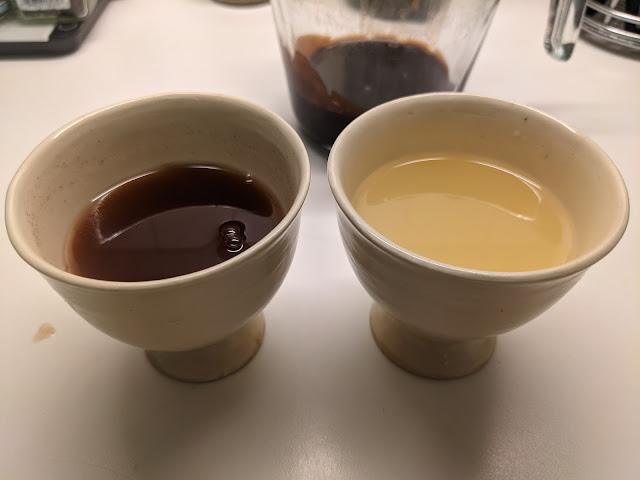笨麴餅酒第六十六 Chapter 66: Lumpy Yeast Cakes and Wine, Part 1: The Lumpy Yeast Cakes
I've finished a draft of an actual recipe! Haven't tried making it of course, but this one goes all the way from raw grain, specifically broomtail millet, through to a finished product.
The "lumpy" part of the title is because I can't find any better translation of 笨 - in modern Chinese, it means "stupid" but that seems like not the right translation. A commentator leaves a cryptic note about the pronunciation of it, so maybe it's an odd usage, or a variant character.
I'm breaking this recipe into two sections: one for the yeast cakes, and one for the wine. It seems to be the case that most medieval Chinese fermented grain products, and indeed many traditional alcohols today, use a combined yeast and aspergillus starter called 酒麴 jiǔqū, which I'm translating as "yeast cakes." They're solid balls or blocks of grain which the yeast and fungi needed to break down the starches in the target grains and then ferment them grow. Here's an example of what modern jiuqu look like:
The "lumpy" part of the title is because I can't find any better translation of 笨 - in modern Chinese, it means "stupid" but that seems like not the right translation. A commentator leaves a cryptic note about the pronunciation of it, so maybe it's an odd usage, or a variant character.
I'm breaking this recipe into two sections: one for the yeast cakes, and one for the wine. It seems to be the case that most medieval Chinese fermented grain products, and indeed many traditional alcohols today, use a combined yeast and aspergillus starter called 酒麴 jiǔqū, which I'm translating as "yeast cakes." They're solid balls or blocks of grain which the yeast and fungi needed to break down the starches in the target grains and then ferment them grow. Here's an example of what modern jiuqu look like:
The translation is rough still, and there are some areas that I don't fully understand yet, so if you have comments I'd love to hear them. As usual, I've interleaved the original Chinese with my English translation, sentence-by-sentence.
笨麴餅酒第六十六 Chapter 66: Lumpy Yeast Cakes and Wine
〈笨,符本切 [pronunciation instructions for “笨”]〉
作秦州春酒麴法:七月作之,節氣早者,望前作;節氣晚者,望後作。To make spring wine yeast cakes in the manner of Qinzhou: in the seventh month, early in the solar term make it before the full moon; late in the solar term make it after. 用小麥不蟲者,於大鑊釜中炒之。Use small wheat/barley without insects, and stir fry it in a big wok [nb: this is not the traditional word for wok (鍋 or 鑊), but Student’s suggests that it’s a similar vessel]. 炒法:釘大橛,以繩緩縛長柄匕匙著橛上,緩火微炒。Stir fry it thus: nail a wooden stake [to something], take a rope, loosely tie it to the handle of a long-handled spoon, attach that to the top of the stake, and slowly fry the grain over a gentle fire. 其匕匙如挽棹法,連疾攪之,不得暫停,停則生熟不均。The ladle should be moved like pulling an oar, continously and rapidly mixing the grain, never stopping - if you stop, the cooked and uncooked grain will become unevenly distributed. 候麥香黃便出,不用過焦。After the grain’s fragrance appears and it becomes yellow, don’t let it burn. 然後簸擇,治令淨。Then, winnow it, making it clean. 磨不求細;細者酒不斷麤,剛強難押。Grind it, but not too finely; if it’s ground finely then the alcohol will be cloudy, and the grain will be hard to press. 預前數日刈艾,擇去雜草,曝之令萎,勿使有水露氣。溲麴欲剛,灑水欲均。A few days before, cut some mugwort [Artemisia argyi, Chinese Mugwort], picking out the weeds, and wither it in the sun, not allowing it to get wet. 初溲時,手搦不相著者佳。First, soak it [presumably the grain?] for some time. When you can grab it with your hand and it doesn’t stick, then it’s done. 溲訖,聚置經宿,來晨熟擣。After soaking, gather it up and set them aside for a night, and at dawn thoroughly pound it [with a pestle]. 作木範之:令餅方一尺,厚二寸。Using wood [presumably a wooden mold], mold the grain into a square cake one chi [~ 1’] on each side, and two cun [~ 2”] thick. 使壯士熟踏之。Get a fighter to really stomp on it. 餅成,刺作孔。After you've made the cakes, perforate them with small holes by piercing them. 豎槌,布艾椽上,臥麴餅艾上,以艾覆之。Set a mallet upright, spread the mugwort on top of some rafters, lay the yeast cakes on top of the mugwort, and use the mugwort to cover them. 大率下艾欲厚,上艾稍薄。Most of the lower mugwort should be thick, and the upper mugwort somewhat thin. 密閉窗、戶。Seal the windows and doors. 三七日麴成。3-7 days later, the yeast balls will be finished. 打破,看餅內乾燥,五色衣成,便出曝之;如餅中未燥,五色衣未成,更停三五日,然後出。Smash them, see that the inside of the cakes are dry and that the multicolored cloth [the colorful layer of bacteria, mycelial hyphae, and spores] is finished, then take them out and sun them; if the middle of the cakes are not yet dry, and the multicolored cloth is not yet finished, then stop for 3-5 days, and then take them out. 反覆日曬,令極乾,然後高廚上積之。Turn the cakes over so they dry in the sun, and gather them in your good kitchen. 此麴一斗,殺米七斗。One dou [10L] of these yeast balls can ferment [lit. “kill”] seven dou of grain.
This work is licensed under a Creative Commons Attribution-ShareAlike 4.0 International License.



Comments
Post a Comment